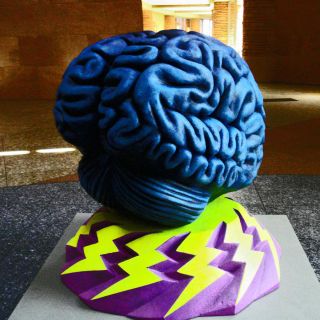Dementia
Virtual Brain May Lead to Real-World Progress in Alzheimer's
Why do researchers want to make a computer-simulated brain develop dementia?
Posted February 24, 2014

A sophisticated virtual brain may help scientists find treatments for real-world brain disorders, such as Alzheimer’s disease and Parkinson’s disease. Although it sounds like the plot for a sci-fi movie, it was actually the subject of a fascinating presentation at the 2014 meeting of the American Association for the Advancement of Science (AAAS), held in Chicago in February.
Terrence Stewart, a postdoc researcher at the Centre for Theoretical Neuroscience of the University of Waterloo in Canada, gave a talk on computer simulation of the whole brain as a tool for medical research. Stewart is project manager for Spaun (Semantic Pointer Architecture Unified Network), a computer model that mimics neuron firing patterns in the human brain.
A Brain Spawned by Computing Power
Spaun can think, remember, see and even draw with a mechanical arm. Compared to the brain inside your head, however, Spaun is still primitive. Stewart said it has 2.5 million neurons, 60 billion synapses and 30 distinct areas. That’s far less than the 100,000 million neurons, 100,000 billion synapses and more than 1,000 distinct areas in the human brain.
Yet compared to other computer models of the human brain, Spaun stacks up well. Although there have been larger-scale neural simulations, Spaun stands out for attempting to show how complex brain activity actually leads to complex behavior.
Spaun can perform a variety of tasks, from copying human handwriting to finding hidden patterns in a list of numbers. But the true value of Spaun may lie not in its abilities but in its quirks and flubs. According to Stewart, Spaun is more like the real thing than other virtual brains because it makes mistakes and loses its abilities much as people do.
Can a Virtual Brain Develop Dementia?
Stewart and his colleagues have already made progress at simulating the brain malfunctions that underlie Huntington’s disease and Parkinson’s disease. To mimic the movement problems caused by Huntington’s, for example, researchers damaged parts of the virtual brain that would be affected by the real-world disease. The resulting errors made by the virtual brain were similar to errors in reaching behavior made by people with Huntington’s.
The Spaun team is also using its model to study the cognitive decline associated with aging. Other research has shown how both the physical brain and people’s behavioral performance on cognitive tests may deteriorate in later life. What has been missing is a clear explanation of how one leads to the other. Stewart and his colleagues hope to provide some answers by modeling the aging process with Spaun.
Up next, said Stewart, is Alzheimer’s disease. Stewart and his colleagues hope to simulate the effects of that disorder by endowing their virtual brain with a hippocampus—part of the brain, essential for forming memories, that is damaged by Alzheimer’s. Then they'll set about giving their brain virtual dementia so they can study its causes and treatment.
Virtual Brains and Real-World Neurology
One goal of this type of sophisticated computer modeling is to help researchers understand how the misfiring of individual neurons can affect the disease process in neurological disorders. Ultimately, that could lead to better targeted therapies.
With future refinements, the virtual brain could one day be used by researchers to study how new drugs affect human performance on cognitive tests before ever giving the drugs to a living animal or person. For example, the virtual brain could potentially be used in the initial testing of a new Alzheimer’s drug to predict how it will affect human memory.
Stewart’s presentation was just one of several talks at the AAAS meeting devoted to the virtualization of the human body. Other talks dealt with computer models of the liver and the hip joint, for instance. But creating a functional model of the dysfunctional brain may be the ultimate challenge. In the long run, it may also yield some of the greatest rewards.
Linda Wasmer Andrews—a writer who specializes in health, medicine and psychology—is just back from reporting on the AAAS meeting. Follow her on Twitter and Facebook.




